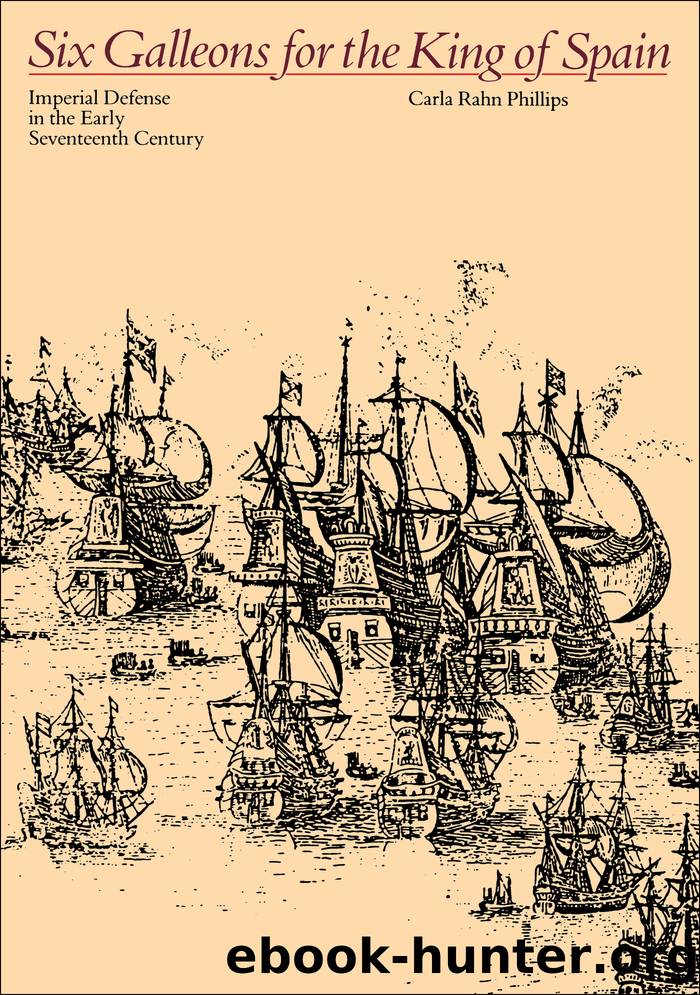Six Galleons for the King of Spain: Imperial Defense in the Early Seventeenth Century by Carla Rahn Phillips

Author:Carla Rahn Phillips [Phillips, Carla Rahn]
Language: eng
Format: epub
ISBN: 9781421441191
Google: Sx75DwAAQBAJ
Published: 2020-09-01T06:22:01.353000+00:00
EIGHT
The Struggle for the Indies, 1629-1635
The âgaliflotaâ of 1629, a war fleet of thirty-five ships, represented a tremendous effort in a year without merchant fleets. Royal ministers scarcely questioned that it had to be sent, despite the chilling losses at Matanzas in 1628. Fortunately the total receipts of treasure and trade in 1628-29 were quite respectable, once the Tierra Firme fleet returned home safely. There is no doubt, however, that the late 1620s and early 1630s marked a slump in the Indies trade, although not as serious a slump as Chaunu claims.1 At that crucial juncture, the crown determined that war fleets had to sail in defense of the empire, whether or not the averÃas on trade could finance them. In the period when MartÃn de Aranaâs galleons served in the Armada de la Guardiaâroughly from 1629 to 1635âthe crown would continue this extraordinary response to the challenge to its empire. Although the cost was high, the results, as we shall see, would repay that expense.
The fleet of galleons in 1629, however unusual it was in some respects, continued the tradition of the Indies run (described in chapter 1) that had been evolving for over a century. Once the âgaliflotaâ left the safety of Cádiz Bay in mid-August, it probably headed briefly down the African coast, then out toward the Canary Islands, following the traditional path of many fleets before it. The voyage from Cádiz to the Canaries could be as short as four days or as long as fourteen, depending on the winds and currents and on whether a ship sailed alone or in convoy. Even a merchant fleet could make it in eight days, if all went well.2 At sea the commander of the 1629 fleet, don Fadrique de Toledo, opened his sealed orders, as generations of commanders had done before him.3 In addition to delivering supplies encountered, the armada of 1629 had a new chargeâto dislodge interlopers from the Lesser Antilles.4 Don Fadriqueâs officers began to plan their strategy, studying what few charts they had of the Lesser Antilles. (See figure 28.) Spaniards had shown little interest in those islands, in part because they had less to offer than the main Spanish bases, and in part because the fierce Caribs who inhabited many of the islands rarely permitted visitors to stay long without attacking them. These islands, then, formed the southern outer fringes of the Spanish empire in the Caribbean, claimed but only tenuously held.
Download
This site does not store any files on its server. We only index and link to content provided by other sites. Please contact the content providers to delete copyright contents if any and email us, we'll remove relevant links or contents immediately.
Room 212 by Kate Stewart(4107)
The Crown by Robert Lacey(4105)
Endurance: Shackleton's Incredible Voyage by Alfred Lansing(3844)
The Iron Duke by The Iron Duke(3639)
The Rape of Nanking by Iris Chang(3516)
Killing England by Bill O'Reilly(3455)
Joan of Arc by Mary Gordon(3258)
Say Nothing by Patrick Radden Keefe(3060)
I'll Give You the Sun by Jandy Nelson(2842)
Hitler's Monsters by Eric Kurlander(2731)
Shadow of Night by Deborah Harkness(2718)
Margaret Thatcher: The Autobiography by Thatcher Margaret(2684)
Mary, Queen of Scots, and the Murder of Lord Darnley by Alison Weir(2678)
Darkest Hour by Anthony McCarten(2645)
Blood and Sand by Alex Von Tunzelmann(2608)
Red Famine: Stalin's War on Ukraine by Anne Applebaum(2463)
Eleanor & Park by Rainbow Rowell(2393)
The One Memory of Flora Banks by Emily Barr(2348)
Book of Life by Deborah Harkness(2263)
